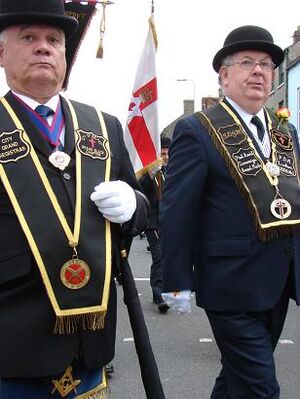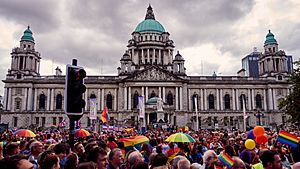Parades in Northern Ireland facts for kids
Parades are a big part of life and culture in Northern Ireland. Many of these parades are organized by Protestant, unionist, or Ulster loyalist groups. However, Irish nationalist, republican, and other non-political groups also hold parades.
Sometimes, there are disagreements about parades, especially if they are seen as controversial. The Parades Commission is a group that tries to help solve these problems. Even though not all groups agree with the Commission, its decisions are legally binding, meaning everyone must follow them.
Contents
Unionist Parades: Celebrating Culture
Most parades in Northern Ireland are organized by Protestant and/or unionist groups. In fact, in 2003/2004, nearly 70% of all parades were from these groups. Because of this, some people feel that trying to limit parades is like attacking their culture.
These parades usually happen on Saturdays. This means people don't have to miss work or school. They also try to avoid parading on Sundays. Many Protestants believe Sundays should be kept for religious activities only. The main exceptions are the parades on the Twelfth of July. These always happen on July 12th, unless that day is a Sunday. If it's a Sunday, the parade moves to Monday, July 13th. Church parades also happen on Sundays.
Orange Institution: Marches of History
The Orange Institution holds hundreds of parades across Northern Ireland every year. Their biggest parades are usually on July 12th. This day is known as 'The Twelfth'. It celebrates the Battle of the Boyne, a very important historical event.
Smaller groups within the Orange Institution, called lodges, also parade at different times. Many of these parades lead up to 'The Twelfth'. Parades are also held in July and November to remember those who died in World War I. They especially remember the 36th (Ulster) Division at the Battle of the Somme. Younger Orange lodges from Armagh, South Tyrone, and Fermanagh parade each year in late May.
On the last Saturday of October, there are major Orange parades to celebrate Reformation Day. In Belfast, these parades often end at Saint Anne's Cathedral for a church service.
Apprentice Boys: Remembering a Siege

The Apprentice Boys of Derry remember the siege of Derry from the 1600s. Their biggest celebration is in Derry on the Saturday closest to August 12th. This parade celebrates the end of the siege.
They also parade on the Saturday closest to December 18th. This remembers when the original apprentice boys closed the city gates. They stopped King James II's soldiers from entering. The Apprentice Boys also parade at Easter. Most of their parades happen in the city of Derry.
Royal Black Institution: Honoring Traditions
The main parade for the Royal Black Institution is on the last Saturday of August. It is called Last or Black Saturday. This parade used to be on August 12th. It also remembered the end of the siege of Derry. But in the 1950s, the date was changed. Smaller parades happen in Belfast in the two weeks before this main event.
Another important event is the 'sham fight' at Scarva on July 13th. In this event, an actor playing William of Orange pretends to defeat an actor playing James II. This re-enacts the victory of William's forces at the Battle of the Boyne. There is also a parade on August 12th in Fermanagh. It celebrates the Battle of Newtownbutler. This parade was moved to the Saturday before August 12th. This was done to attract more people.
Salvation Army: Peaceful Marches
The Salvation Army in Northern Ireland sometimes parades with brass bands. These parades are usually not seen as controversial or linked to any specific group. They have not caused any problems.
Bands: Music and Competition
Many marching bands parade on their own. They also join the parades of other groups. Band parades are often held to raise money. Sometimes, they are part of band competitions. Other bands from the United Kingdom are invited to compete. Over 100 bands might join a single parade.
Band parades happen more often than loyal order parades. There are many parades every weekend from early April until the end of September.
Nationalist Parades: Fewer but Significant
Parades are much less common among nationalist or republican groups. The Parades Commission says that less than 5% of parades in Northern Ireland are nationalist/republican.
Ancient Order of Hibernians: Cultural Celebrations
The Ancient Order of Hibernians parade less often than most Protestant groups. Their main parades are on Saint Patrick's Day, at Easter, and on Lady Day. During a difficult period called the Troubles, the Hibernians sometimes offered to stop parading if Protestant groups did the same.
Irish National Foresters: A Fraternal Group
The Irish National Foresters are a nationalist group that welcomes Irish people of any religion. However, most of their members are Catholic. Their main parade date is the Sunday closest to August 1st.
Republican Parades: Remembering Key Events
Northern Ireland's biggest yearly republican parade happens in August. It is part of Féile an Phobail, a festival. This parade started as a protest against people being held without trial. It grew into a festival that celebrates Gaelic and republican culture.
Republican parades also happen in January to remember Bloody Sunday. At Easter, they remember the 1916 Easter Rising. There is also a republican march every year to remember the 1981 Hunger Strike. Important republican figures like Martin McGuinness and Gerry Adams often attend this parade. Irish Republican bands from Scotland, England, and Ireland also join these parades, especially the August march for the Hunger Strike anniversary.
Civil Rights Marches: Seeking Fairness
In the late 1960s and early 1970s, groups like the Northern Ireland Civil Rights Association (NICRA) and People's Democracy held protest marches. They wanted to show the world that Catholics in Northern Ireland faced unfair treatment in politics, society, and jobs.
These civil rights marches and how people reacted to them were a big reason why The Troubles started. This was partly because the police sometimes used too much force.
Easter: A Start to the Season
Easter is a major time for parades for both communities. It is often seen as the start of the year's 'marching season'. Several republican groups also remember the Easter Rising at this time.
According to an expert named Neil Jarman, Protestants started parading at Easter in the 1930s. They did this to respond to republican parades. But today, "few people are aware of this," and Easter parades are now a normal part of the loyalist tradition.
Non-Sectarian Parades: For Everyone
Some parades in Northern Ireland, especially in Belfast, are not linked to any specific religious group. They follow the same rules as other parades.
Lord Mayor's Parade: City Celebrations
Several cities in Northern Ireland have Lord Mayor's parades. These parades mark the end of the mayor's time in office. They are usually like carnival events. They grew from older, more formal parades held in many cities in the United Kingdom since the Middle Ages. The Belfast parade happens in May. In 2007, its theme was 'Love and Friendship'.
Belfast Pride: Celebrating Diversity

An LGBT+ Pride parade has been held in Belfast every year since the early 1990s. Northern Ireland has many people with strong Christian beliefs. Because of this, the parade is often seen as controversial by some. In 2005, some Christian groups asked for it to be banned. But the Parades Commission said it could go ahead. Belfast Pride is sometimes called one of the few events in Northern Ireland that truly brings different communities together.
Remembrance Sunday Parades: Honoring Those Who Served
War memorial parades are mostly attended by the unionist population of Northern Ireland. However, in recent years, nationalists have also started to take part. Some war memorial parades are run by Protestant groups like the Orange Order.
But parades on Remembrance Sunday (the Sunday closest to November 11th) are different. They are organized by local councils or the British Legion. These parades remember war dead from all religious backgrounds. Remembrance Sunday parades usually involve veterans or local military units marching to a ceremony. This ceremony is often held at a war memorial. Then, there is often another march to a church service.
There are many parades on St. Patrick's Day across Northern Ireland. This parade celebrates St. Patrick, who is the Patron Saint of Ireland. He is recognized as the patron saint of the whole island of Ireland. He is important to both Nationalists and Unionists. In recent years, loyal orders like the Orange Order and the Apprentice Boys of Derry have even held parades to mark St. Patrick's Day.
Youth Organisations: Learning and Marching
Some youth organizations, like the Boys' Brigade, take part in or organize parades and drills throughout the year.
Dates of Major Parades
| Date | Groups involved | Event |
|---|---|---|
| 17 March | Various | Saint Patrick's Day |
| Easter Sunday | Republicans | Commemorates the Easter Rising (1916) |
| 5 May | Republicans | Commemorates the republican hunger strike (1981) |
| 1 July | Various groups, mostly unionist | Commemorates the Battle of the Somme (1916) |
| 1st Sunday in July |
Orange Order | "Drumcree Sunday" |
| 12 July | Orange Order | The Twelfth |
| 9 August | Republicans | Commemorates the introduction of internment (1971) |
| Saturday nearest 12 August |
Apprentice Boys of Derry | Commemorates the relief of the Siege of Derry (1689) |
| −15 August | Ancient Order of Hibernians | Lady Day |
| last Saturday in August |
Royal Black Institution | "Black Saturday" |
| last Sunday in October |
Orange Order | Reformation Day |
| 2nd Sunday in November |
British Legion and others | Remembrance Sunday |
| Saturday nearest 18 December |
Apprentice Boys of Derry | Commemorates the shutting of the gates by the 13 apprentice boys during the Siege of Derry (1688) |
How Many Parades?
In 2007, the Parades Commission reported that 3405 parades (not including funerals) took place in Northern Ireland. The table below shows how these parades were grouped by type and who organized them.
| Organisation or type | Political affiliation | Number of parades | No. of sensitive parades |
| Loyalist bands | Unionist | 483 | 33 |
| Orange Order | Unionist | 452 | 23 |
| Civic (including schools, trade unions, community groups) | Non-aligned, mixed or either | 249 | 5 |
| Apprentice Boys of Derry | Unionist | 231 | 17 |
| Royal Black and Royal Arch Purple | Unionist | 167 | 5 |
| Church parades (including Boys' Brigade, Girl Guides, Legion of Mary etc.) | Non-aligned | 157 | 0 |
| Military (including British Legion) | Non-aligned | 149 | 1 |
| Other | 98 | 0 | |
| Nationalist bands | Nationalist | 59 | 11 |
| Other nationalist/republican (includes political parties) | Nationalist | 51 | 5 |
| Hibernians and Foresters | Nationalist | 28 | 2 |
| Other unionist (includes political parties) | Unionist | 21 | 0 |
| Residents' groups | Nationalist | 6 | 2 |
| Total unionist/loyalist (excluding church parades) | 1354 | 78 | |
| Total nationalist/republican (excluding church parades) | 144 | 20 |
The Police Service of Northern Ireland (PSNI) keeps slightly different records. In 2007, they counted 2863 parades. Of these, 2270 were loyalist, 144 were nationalist, and 449 were neither. Only four parades were illegal, and three of those were nationalist.
The PSNI also reported that 45 parades had to change their routes. All but two of these (one nationalist, one other) were loyalist. Rules were put on 78 other parades. 70 of these were loyalist, 7 nationalist, and one neither.
Problems or disorder happened at only ten parades. Nine of these were loyalist, and one was nationalist. This was a big improvement from previous years. In 2005, problems were reported at 34 parades.

